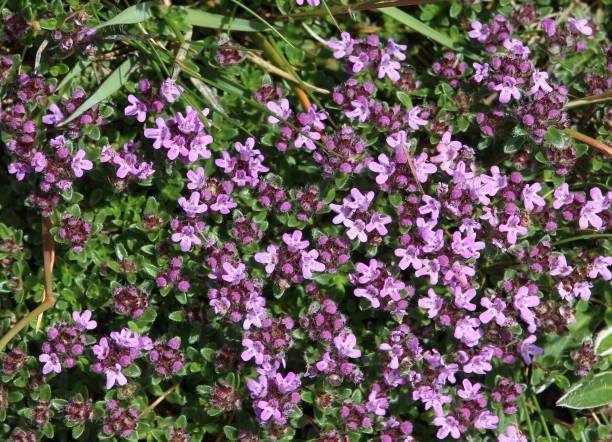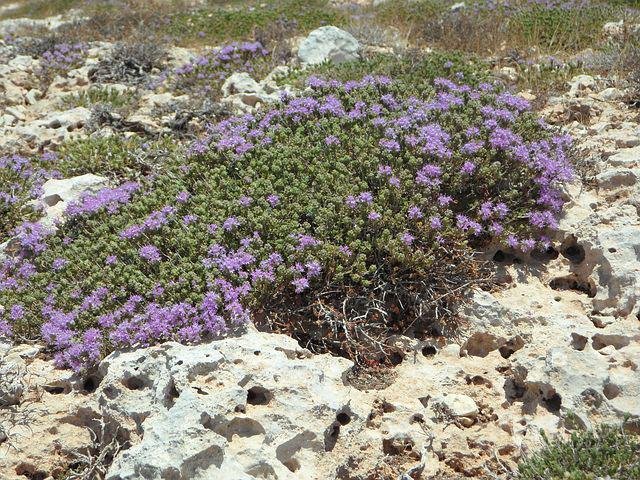Creeping Thyme (Thymus Serpyllum) is one of the several woody-stemmed perennial species of the Thymus genus that are good ground covers for sunny areas and landscape designs. It is a perennial herb that will over-winter well in zones 4-9 and prefers well-drained soil with a neutral pH between 6.5 and 7.5 in an area where it can receive good sun but can also tolerate partial shade.
Creeping Thyme is principally grown for the delicate texture of its leaves as they spread out to softly blanket the ground. They can also produce flowers of various colors depending on the type. Its flowers usually appear in late spring and early summer from established plants.
| Common Name | Creeping Thyme |
| Botanical Name | Thymus Serpyllum |
| Family | Lamiaceae |
| Plant Type | Herbaceous Perennial |
| Mature Size | 2-6 inches tall and 6-8! inches wide depending on the type. |
| Exposure | Full sun or partial shade |
| Soil Type | Well-drained, loose, rocky and Sandy. |
| Soil pH | Neutral |
| Bloom Time | Summer |
| Flower Color | Pink, White, Purple |
| Hardiness Zones | 4 – 9 USDA depending on the variety |
| Native Area | Europe |
How To Grow Creeping Thyme

Creeping Thyme is tolerant of drought conditions, but water-logged soil is harmful to its production and survival. It grows best in warm, sunny climates at temperatures between 4 and 28°C (39.2 – 82.4°F), but it will grow best at 16°C (60.8°F).
Creeping Thyme will thrive best in well-draining fertile Sandy loam or sand and should be planted in alkaline soils with full sunlight for optimum productivity. You can grow Creeping Thyme in three methods: division, stem cuttings, and seeds.
How To Grow Creeping Thyme By Division
Before starting, make sure you use this method in either spring or fall for a smooth re-establishment. Results have proven that the warmer weather and longer spring days help the plant increase and gain new growth. While in fall, the plants tend to huddle and invest more energy in their roots.
1 . To get started, select a plant you have watered recently. Use a pot with at least 3 inches of growth on all sides and below the plant.
2. Dig around the plant in a circle about 3 to 4 inches from the center of the plant. Careful not to cut through the roots, and if you do, it’s beautiful.
3. Go ahead and divide. Cut through the middle of the plants keeping the roots intact. As long as you have healthy roots, make multiple cuts. If you have old soil around your plant’s roots, shake it off.
4. Put your soil at the bottom of the pot and center the plant in the middle. Make sure the plant has the same soil line as before. Add soil around all sides of the root ball and add water until you see water run out the bottom.
Be careful not to let the soil appear soggy. Go ahead and place it in a sunny location.
How To Grow Creeping Thyme From Stem Cuttings
Equipments needed
- Healthy non-flowering stem with new leaf growth.
- I sterilized scissors or pruners.
- Fresh well-draining soil.
- Clean pot.
- Rooting hormone (Optional)
- Sunny Pot (Optional)
1 . Cut the stem 4 to 6 inches long and remove the bottom 2 inches of leaves. If you are using rooting hormone, Go ahead and apply it to the cut end of the stem.
2. If you are not using rooting hormone, develop the roots in a clean, clear glass of filtered water. Place the cutting in a sunny Pot and wait till new roots develop. Roots development can take up to three-four weeks.
3. With Rooting Hormone in place, plant the stem cutting in the center of the new container with fresh soil. Place the plant in a sunny Pot and water it to keep the soil consistently moist by not being soggy.
How To Grow Creeping Thyme From Seed
You can grow Creeping Thyme from seed either indoors, in the greenhouse, or outdoor after the danger of frost has passed. Plant the seeds on the soil’s surface with a light covering the soil. The seeds germinate for seven to twenty-one days at 65 to 70°F.
To moisten the top of the soil, use a spray bottle, and once the seedlings have 3 to 4 inches of growth, you can transplant them into a new container or plant them in the ground after the danger of frost has passed.
How To Care For Creeping Thyme
Creeping Thyme will thrive in excessively clay Sandy soils. It will grow between 2-3’high, and each established plant can spread approximately 1’wide.

It is hardly a plant that doesn’t have any problems, although, like many other plants, it is susceptible to root rot in wet-soggy soil.
1 . Light
Creeping Thyme thrives in full sun, though it can tolerate partial shade.
2. Water
Creeping Thyme is reliably drought-tolerant once established. Water new plants regularly until they are established.
3. Temperature And Humidity
Creeping Thyme doesn’t like humidity. Prune the thyme as needed to keep it bushy and dense.
4. Fertilizer
Creeping Thyme that grows in well-prepared soil shouldn’t be fed. If the soil is poor, you can provide a delayed-release fertilizer at the beginning of the growing season.
5 Common Varieties Of Creeping Thyme You Can Grow
1 . English Thyme
English Thyme (Thymus Vulgaris) is also known as Common Thyme or Garden Thyme. It is the best known Thyme variety and is typically grown as a culinary herb.
2. Red Creeping Thyme
Red Creeping Thyme (Thymus Serpyllum Coccineus) is known for its pink flowers and tolerance for relatively poor soil. It can grow 3 to 4 inches tall and 12 to 17 inches wide.
3. Lemon Thyme
Lemon Thyme (Thymus citriodorus) has yellow tinted leaves to season teas, salads, and savory dishes.
4. Woolly Thyme
Woolly Thyme (Thymus Pseudolanuginosus) is best known for its pale pink flowers. It can grow 3 inches tall and 3 to 12 inches wide.
5. Spicy Orange Creeping Thyme
Like Woolly Thyme, Spicy Orange Creeping Thyme is known for producing pink flowers. The flowers grow 2 to 4 inches tall.
Common Pests And Diseases
Creeping Thyme does not tend to be bothered by insects. They also resist diseases, but like other plants, they can become vulnerable to bacteria, fungi, and viruses.
The diseases that affect Thyme most are root rot (Rhizoctonia), Grey mold (Botrytis Andrea), and Alternaria Blight (Alternaria brassicicola). Diseases can spread through the soil, water, air, infected tools, and animals.
To prevent these diseases, you need to research the risk, that is, to find out about Thyme diseases that are prevalent in your geographic area. Examine your plants daily and spot diseases early.
Frequently Asked Questions
1 . Where Is The Best Place To Plant Creeping Thyme?
Creeping Thyme plants grow best in well-drained soil with a neutral to slightly alkaline pH. They also grow well when exposed to full sun.
2 . Can You Walk On Creeping Thyme?
Creeping Thyme can be walked on. It includes several walkable ground covers such as Red Creeping Thyme, Woolly Thyme, and Mother-of-thyme.
3. Is Creeping Thyme The Same Thyme?
Both Creeping Thyme and Thyme are edibles. However, the main difference is that Thyme is grown for culinary use, while Creeping Thyme is grown primarily for landscaping.
4. Is Creeping Thyme Toxic To Dogs?
Creeping Thyme is safe for dogs. They are also drought-tolerant evergreens.
